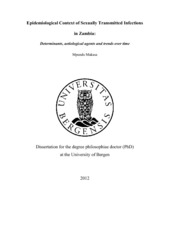| dc.contributor.author | Makasa, Mpundu | en_US |
| dc.date.accessioned | 2013-01-18T09:25:10Z | |
| dc.date.available | 2013-01-18T09:25:10Z | |
| dc.date.issued | 2012-12-06 | eng |
| dc.identifier.isbn | 978-82-308-2170-1 | en_US |
| dc.identifier.uri | https://hdl.handle.net/1956/6274 | |
| dc.description.abstract | Background: Sexually transmitted infections (STIs) remain a challenge mainly in developing countries, and in particular in sub-Saharan Africa, which also faces a serious HIV epidemic. Sexually Transmitted Infections can lead to serious complications such as infertility, spontaneous abortions, still births, cervical cancer and also enhance transmission of HIV. Control of STIs is thus important. Many STIs are curable, and prompt care seeking shortens the duration of an STI and prevents complications in the source patient as well as secondary spread of the infection. The World Health Organization recommends the use of syndromic guidelines for the management of STIs in countries with limited diagnostic facilities. A search of the literature showed gaps in current information on STIs in Zambia. This thesis focused on the causes of genital ulcer disease (GUD), its predictors, healthcare seeking and sexual behaviour among individuals with genital ulceration, and further examined syphilis trends in pregnant women compared with changes in the general population. Methods: The thesis utilised data from the Antenatal Clinic (ANC) sentinel surveillance system, the Zambia Demographic and Health Surveys (ZDHS) and a cross sectional survey of 200 patients with GUD in Lusaka district. Both the ANC and ZDHS data comprised information from interviews as well as syphilis and HIV test results. In the GUD study, swabs from the genital ulcers were tested for Treponema pallidum, Herpes Simplex types 1 and 2, Haemophilus ducreyi, and Chlamydia trachomatis using polymerase chain reaction (PCR). Results: The ANC surveys showed an overall significant decline in syphilis trends between 1994 and 2008 among urban and rural women. The decline was sharp irrespective of educational level, however, there were striking provincial variations noted. A comparison with the ZDHS 2001/2 and 2007 data also showed an overall reduction (though not significant), in syphilis prevalence among urban and rural men and women in the general population. The pathogens detected by PCR from the 200 patients with GUD in Lusaka were as follows: Herpes Simplex Virus type 2 (HSV-2) was detected in 28% of ulcers, Treponema pallidum in 11%; Chlamydia trachomatis in 3%; Herpes Simplex Virus type 1 in 0.5%, and Haemophilus ducreyi was not detected at all. Fifty five percent of the patients did not have any pathogens detected from their ulcers. The 2007 ZDHS showed a low prevalence of self-reported genital ulcers (GU) in the general population (3%). Important predictors for GU were age (25-39 years), being widowed/separated/divorced and having had a high number of lifetime sexual partners. No differences in care-seeking for GU were observed by age and gender, and more than half the respondents sought care from public health facilities. Among patients that presented with GUD in Lusaka, 57% reported sex after onset of symptoms and only 15% of these reported consistent condom use. Conclusion: Syphilis declined by about 60% or more in rural and urban pregnant women between 1994 and 2008. The variations however that were noted at provincial level need to be studied further to understand the local context of the epidemics, and to guide STI prevention and control programmes in the different geographical settings. Detection of pathogens using PCR showed that HSV-2 was the commonest cause of GUD among patients with genital ulceration in primary health care clinics in Lusaka. The fact that Haemophilus ducreyi was not detected in any of the patients requires further studies. If the findings are validated, treatment guidelines for GUD need to be revised in Zambia. Since the majority of the respondents who reported symptoms of GU also reported having sex and only a minority had used a condom, there is need for awareness campaigns on the importance of abstinence or use of condoms when experiencing symptoms of GUs. | en_US |
| dc.language.iso | eng | eng |
| dc.publisher | The University of Bergen | eng |
| dc.relation.haspart | Paper I: Makasa, M., Fylkesnes, K., Michelo, C., Kayeyi, N., Chirwa, B. and Sandøy, I. (2012) Declining syphilis trends in concurrence with HIV declines among pregnant women in Zambia: observations over 14 years of national surveillance. Sexually Transmitted Diseases 39(3): 173-181, March 2012. Full text not available in BORA due to publisher restrictions. The article is available at: <a href="http://dx.doi.org/10.1097/OLQ.0b013e31823b23a4" target="blank"> http://dx.doi.org/10.1097/OLQ.0b013e31823b23a4</a> | en_US |
| dc.relation.haspart | Paper II: Makasa, M., Fylkesnes, K. and Sandøy, I. (2012) Risk factors, healthcare-seeking and sexual behavior among patients with genital ulcers in Zambia. BMC Public Health 2012, 12:407, June 2012. The article is available at: <a href="http://hdl.handle.net/1956/6273" target="blank">http://hdl.handle.net/1956/6273</a> | en_US |
| dc.relation.haspart | Paper III: Makasa, M., Buve, A. and Sandøy, I. (2012) Etiologic pattern of genital ulcers in Lusaka, Zambia: Has chancroid been eliminated? Sexually Transmitted Diseases 39(10): 787-791, October 2012. Full text not available in BORA due to publisher restrictions. The article is available at: <a href="http://dx.doi.org/10.1097/OLQ.0b013e31823b23a4" target="blank"> http://dx.doi.org/10.1097/OLQ.0b013e31823b23a4</a> | en_US |
| dc.title | Epidemiological Context of Sexually Transmitted Infections in Zambia: Determinants, aetiological agents and trends over time | en_US |
| dc.type | Doctoral thesis | |
| dc.rights.holder | Copyright the author. All rights reserved | |

